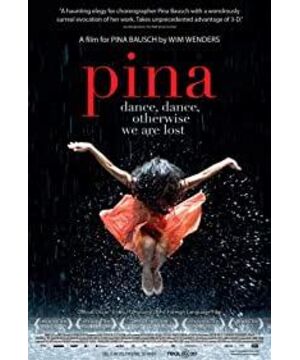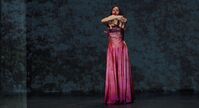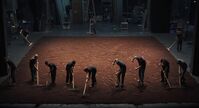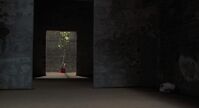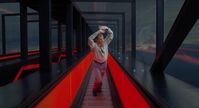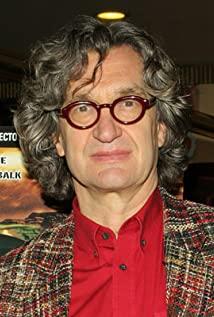As far as the film itself is concerned, it is not good or not, at least the lines and shapes of the stage are broken. Traditional dance composition is not so easy to embody. What we see is a lens swap. Includes close-up emoji language. But what is interesting is that the rendering of the atmosphere and the shaping of the image have all become close-ups. And his 3D glasses are interesting, the left is cool and the right is warm. It seems that I often switch left and right, which is not natural. Wenders sees Pina from a filmmaker's perspective. Everyone has her own personality, and the work reflects only one aspect. It is found that her attitude towards life determines the style of the work. Pina speaks very little, she always sits quietly, but she talks a lot when she communicates with actors. When she thinks of something, she will call an actress to her side and chat with her, sometimes chatting and chatting, The actress would burst into tears and weep bitterly. After chatting with her, the actor would have a special feeling when he returned to the stage. She expresses the dance with pain, perhaps the form is not important. Just like in the movie Lipina. She said that the speech itself is not important, but the thought conveyed.
In fact, looking at Pina's stage image, she does not need more technical presentation. She is already three-sided, not 3D, but may be 5D. There are several photos in the movie. Her sunken eyes are bright and unfathomable, and her temperament has always contained shyness and fear. She is friendly and at the same time keeps a certain distance from strangers. This reminds me of Gert Weigelt's writing in the Pina Photography Exhibition: "It is almost impossible to approximate and interpret such a magnificent and complex life work of a brilliant dancer. Compared to trying to find a method of documenting that is ultimately doomed to fail, photography is about another quality—the self-discipline of art. Capturing the essence of the entire dance performance through just one photo has always been my goal. It’s a utopian intention, but it’s also necessary if people insist on using an absolute measure to measure their work.”
Pina is rarely seen in the film, her arms dancing with the flow of emotions, and her expression is sometimes Sad and sometimes arbitrary. In those moments of forgetfulness, it seemed that she was the only one in the world to dance. This picture is the end of the movie, and Pina's black and white solo dance is less than 2 minutes. She probably understands the pure value very well, and even when expressing the strong contrast between ecstasy and anguish, she does not want to use overly exaggerated colors to set off the burning inner emotion.
Almodovar's film "Tell Her". Almodóvar chose Pina Bausch's most desperate work, "Café Mueller," in this splendid Spanish heterochromatic film. Pina Bausch, with her eyes closed and her hands lowered, ran across the stage and hit the wall in agony as a man kept clearing the chair in front of her. There is no communication between them, the man is more like an invisible man, like a symbol of violence in Pina Bausch's personal memory; this obviously autobiographical work is obtained after another younger female dancer appears. Confirmed: this girly dream was watched and swallowed by men.
Café Mueller wanders unconsciously and vulnerable like a shadow in the café, contrasting with a man and a woman. This pair of men and women, who need and reject each other, are in the contradiction of love, hate and indifference. They seem to be performing a story in the cafe, a close and violent emotional drama, which is completely controlled by the relationship between the two. , Pina's solo dance seemed completely unnoticed. However, this dance is unforgettable because of her existence. Her erratic and amnesia seems to have become a symbol of living death. She was there, visible and invisible, near and far.
"Spring Season" is a classic work in my eyes, and it is also the beginning of the movie. Using Stravinsky's music, there is perfect musicality and timing. Once again, the story was written on the ground with the body: what started as a smooth surface turned into a chaotic battlefield in the end. The soil smeared the women's thin clothes, smeared their cheeks, and covered the bare upper bodies of the men. People's worship of the earth is like a ceremony for both sexes. After the ceremony, the sexes return to their original separation. A very expressive dance clearly portrays the disparate personalities of men and women. Here both are captured by a decisive and binding rhythm. The women form a small circle in terror, one after the other. Go to the man's leader to accept the skirt. He lies on his skirt, a symbol of his right to decide on the victim. When the male leader handed the sacrificial victim back into the hands of the stunned women, she began a dance of death under their astonished gazes.
After watching a lot of video materials, I came to the conclusion that Pina's artistic features are manifested in three aspects. One: Broken Dance Theater Two: Profound Expression of Gender and Violence What comes out is the ultimate humanistic concern.
Pina Bausch in my eyes
I don't remember Pina Bausch, like Fassbender, who was so angry that she wanted to shoot the actors in front of her with the camera. Pina Bausch's neurotic madness is restrained, and she always looks exhausted and pale with a mixture of gratitude and exhaustion. She smokes nervously and then presents it with more extreme dances. Her emaciated frame erupted into one phantom dance after another, the tension was unbelievably emotional, and most of it was about pain.
Pina Bausch's movements create an atmosphere or tell a concept. The movements are not just about being beautiful and smooth, but there are many movements that simulate daily life. As one of the important birthplaces of modern dance, Germany has been developing slowly under the shadow of war, full of pessimistic sentiment. Under the German tradition of rationality, German modern dancers were the first to establish movement norms and theoretically analyze ontology, although the purpose of their dance is irrational, emphasizing the self-experience of personal emotions.
Pina Bausch introduces a new approach where she asks dancers questions such as: What do you understand by love? why are you proud? The dancers would answer these questions and express them with movements, while she just sat and watched. She is known for her observant and picking movements. She hardly demonstrates any movements, she just sits there, smoking a cigarette, watching, writing in a small notebook, thinking. It was a concrete shift in her personal initiation of a new theater aesthetic—dance theater.
Pina Bausch completely tells how German women liberate their bodies, such as the exquisite figure in Asia, the sexy breasts of women in European dance, Pina completely strips the world's concept of women, this woman has nothing, Without a pretty face, or even a chest, she broke these meaningless symbols, the symbols of gender, she told the audience that human nature is three-dimensional and abstract, not what you can see by appearance, you see the pain she shows, it's all. It is the most beautiful side visually, but it will be difficult to accept this beauty. She did not give up, although she was always struggling, she was persistent and brave.
View more about Pina reviews


